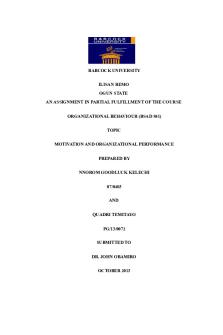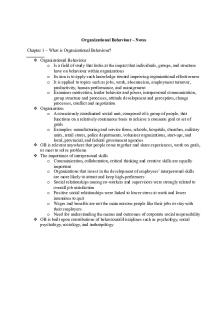King and Lawley (2016) Organizational Behaviour, Oxford University Press PDF

| Title | King and Lawley (2016) Organizational Behaviour, Oxford University Press |
|---|---|
| Author | Daniel King |
| Pages | 25 |
| File Size | 738.9 KB |
| File Type | |
| Total Downloads | 106 |
| Total Views | 147 |
Summary
1 Introducing organizational behaviour Transitions and new beginnings Why read this introduction? This chapter answers two key questions. 1. What am I studying? The chapter will give you an overview of the key themes within organizational behaviour (OB) to help you understand what they are and how t...
Description
1
Introducing organizational behaviour Transitions and new beginnings
Why read this introduction? This chapter answers two key questions. 1. What am I studying? The chapter will give you an overview of the key themes within organizational behaviour (OB) to help you understand what they are and how they connect. This chapter aims to give you a good understanding of the key theories you will cover, and the underlying disciplines that they are based on. 2. How do I study OB? Studying OB is not simply taking in a series of theories that can then be reproduced in an essay or an exam. To gain a higher grade and really understand OB requires the ability to think critically, to question your own assumptions, and to apply the theories to real life contexts. Throughout this chapter we will look at some of these skills and how you can develop them, including the importance of critical thinking, the transition to degree level, and some top tips that will help you succeed in this subject.
Introducing organizational behaviour Running case: transitions and new beginnings—Simon Chance starts his reign It is 7:45 am and Simon Chance, the newly installed Chief Executive of Junction Hotel and President of Second-Chance Consortium, sits at his desk surveying his group’s latest acquisition. The Second-Chance Consortium has just bought Junction Hotel, an upmarket, city-centre hotel with a proud heritage of strong customer service and a traditional approach. In its heyday people would flock to the hotel for its high-class service, great food, and friendly but formal style. Those days, however, are long gone and the hotel has undergone numerous changes of ownership and attempts to revive it. With paint peeling off the walls, worn carpets, and an antiquated computer system, Junction Hotel is in need of some real investment. Chance’s office is a bit like Junction Hotel—faded glory. A dark green leather chair from the 1940s sits in the corner—stylish but uncomfortable. Instead, Chance decides to use a chair from IKEA—not the most elegant design, but far more practical. The room is oak-clad, but some of the wooden panels are loose and a couple now have gaps in between them. ‘I must fix that,’ Chance muses. ‘This place is a mess, nothing works properly, but I am sure we can turn it around.’ The Second-Chance Consortium is a venture capitalist company specializing in turning failed businesses into profitable enterprises. Simon Chance, a former footballer who retired early because of injury, reinvented himself as a business entrepreneur. Teaming up with his former agent and self-styled business guru Phil Weaver, Chance has led the consortium for six years, starting with the local football team and gradually building up a portfolio of successfully transformed firms. Chance feels confident that he can make the hotel a success. ‘They just need strong leadership and a good strategy,’ he thinks. ‘I am sure that we can succeed here.’
2
Chapter 1
Introducing organizational behaviour
At first glance, running an organization might seem straightforward. Television programmes such as Dragons’ Den often give the impression that all you need is the right product, marketing, and finance to be successful. Equally, you might look at your own boss or the manager of a football team you support and think, ‘why don’t they just tell them to get on with it? If I were in charge we could quickly sort it out.’ Yet, in practice, running organizations is more complicated. Organizations can be difficult, challenging places, largely because they involve people. People can be unpredictable and complex as they have their own agendas (e.g. the desire to be seen as a success, fear of failure, etc.), beliefs (e.g. this is the right way to do things), identities (e.g. I am an accountant and this is how I do things), practices, and habits, all of which shape how they act. To manage, or even work alongside, people you need to be able to understand how they think, what motivates them, what increases their commitment, how to organize them, and how to ensure they act in an ethical and sustainable way (Figure 1.1). Working with and managing people, therefore, is likely to be one of the most difficult and challenging things that you do. People are, therefore, are at the heart of this book; in particular we focus on how they are managed, motivated, trained, and led, and how they communicate. At the individual level we examine their personality, motivation, and learning; at the group level, how they are managed through teams and groups; and, at the organizational level, how they are led, impacted by power and politics, and affected by the organization’s culture.
Figure 1.1 The way individuals are managed.
The rational organization
• Bureaucratic procedures— following rules and regulations • Taylorism—following set work procedures • Rational organization today —Rational principles spread throughout society
Contemporary trends
• • •
Globalization—working in a global world The service sector—emotional and aesthetic labour Corporate social responsibility —acting ethically
Managing the organization
• • • •
Change—top-down change Leadership—following the leader Power and politics—power games Communication—top-down communication
The Social Organization
Ways in which the individual is managed
• Social organization—power of peer pressure • Groups and teams—managed through teamwork • Organizational culture— changing hearts and minds
Managing the individual
• Individuals and personalities—through personality tests • Motivation—becoming self-motivated • Knowledge and learning—training and developing the individual
Chapter 1
Introducing organizational behaviour
OB is also about how organizations are structured and run through systems and procedures, as well as how they relate to the wider, globalized world. Furthermore it is about society—or, more precisely, the impact that organizations have on the people that work for them, the communities around them, and society as a whole. It examines how organizations operate globally and also impact, for good and ill, society and the planet. To study OB, therefore, is to really begin to understand how and why things happen at work, what is the most effective way of achieving things, and what impact this has on the people that work for organizations and the societies in which they operate.
Running case: understanding the complexity—our fictional case study, Junction Hotel From: Sent: To: Subject:
Phil Weaver 2 September Simon Chance Junction Hotel Report
Hi Simon I have done a full survey of the hotel, looking back at its accounts for the last five years and surveying the building, kitchen, and staff. Having stayed in the hotel overnight as part of the mystery shopper exercise I found the staff courteous and friendly, but the systems slow and cumbersome. Checking in took 20 minutes as they had lost my registration details, and we had to walk to the restaurant in order to pay my bill as the ‘machine was not working’. The rooms were comfortable and fairly clean, but did seem to be of an inconsistent standard. I must say that the food at the restaurant was excellent and shows real class, but service was slow. Overall, this hotel shows potential but there is much to improve. They are quite disorganized, some staff seem unmotivated and unclear in their tasks, and the service, while polite and professional, is not what you would expect. Speak soon Phil Chance turns to the main report. The Second-Chance Consortium always create a comprehensive report when they take over a failing venture and collect good management data so that they can work out what to improve. Chance reads about the hotel’s history and is interested to learn that back in its heyday, Junction Hotel hosted some stars from the stage and screen, its restaurant won awards, and it had successful conference facilities. As he reads more of the report, however, his mood changes. ‘This won’t be a quick fix,’ he thinks, looking in detail at the problems that Weaver identified: poor systems, unmotivated staff, erratic schedules, no clear identity or purpose to the hotel, and running at a loss for the last five years. ‘We need to sort this place out,’ Chance thinks, staring out of the window. ‘I’ll get Weaver on the phone and work out our plan.’
3
4
Chapter 1
Introducing organizational behaviour
What do you think are the key challenges that Simon Chance faces in transforming Junction Hotel?
Visit the Online Resource Centre to read the full report. The complexity of organizations is often best understood in the context of familiar situations. In this book we will do this through our innovative fictional running case study, Junction Hotel. Instead of seeing theories as dry abstract models, in this book we use them as ways to make sense of the challenges the characters face. Through this case study we will learn about the hotel’s characters, their personalities, backgrounds, and experiences, and the dilemmas they face. We will see their emotions, reactions, and different interpretations of the same event. Applying theory to real situations is suggested by learning theorists, such as Kolb and Gibbs, to be far more effective. It helps us understand real dilemmas and challenges that managers, workers, or society face. Just think of it this way: a manager does not try to motivate their staff because a textbook says that they should do it; rather, they look at ideas surrounding motivation because they are facing a problem that they need to solve. The theories covered in this book were largely produced in response to challenges in real life. So, as you read the theory in this book try relating the theories to your own experiences—cases you know from real life—and to our fictional case, Junction Hotel.
What is organizational behaviour? So, what is involved in running and working in organizations? This book will be divided into five themes, each with their own focus and issues. 1. The rational organization. 2. The social organization. 3. Managing the individual. 4. Managing the organization. 5. Contemporary trends. As we will see, these themes offer us a different perspective on what goes on within organizations and different ideas about how to manage them (Figure 1.2).
Theme 1: The rational organization Chapter 2: Rational organizational design and bureaucracy Chapter 3: Rational work design Chapter 4: Rationalization in contemporary organizations
Chapter 1
Introducing organizational behaviour
Figure 1.2 Key themes in organizational behaviour.
Managing the organization
• Communication • Power and politics • Leadership • Change
Contemporary trends
Managing the individual
• • •
Individuals and personality Motivation Knowledge and learning
The social organization
• The social organization • Groups and teams • Organizational culture
5
Ways in which the individual is managed
• Globalization • The service sector • Corporate Social Responsibility
The rational organization
• Bureaucracy • Taylorism • Rationalization today
Running case: 8:15 am Phil Weaver discusses his report with Simon Chance ‘We need systems and procedures,’ Weaver states boldly to Chance, ‘like we had at the football club, to make this place run like clockwork.’ Weaver animatedly discusses his plans with Chance. ‘I’ve been looking at the booking-in procedure. I’m sure we could make it run quicker by streamlining it. Also, the cleaners seem to be getting away with murder—working slowly without set targets or procedures,’ he continues, hardly taking a breath. Getting out a grid drawn on a sheet of A3 paper, Weaver lays out targets for every individual and department, with measurements for every aspect of the hotel—from customer satisfaction through to room cleanliness. ‘It’s another Weaver masterplan,’ Chance declares excitedly. Impressed, Chance picks up a document entitled ‘Streamlining food production,’ which has detailed step-by-step guides to peeling carrots through to cooking chicken. ‘I’ve only just started,’ Weaver states. ‘I think we should work on the cleaners first. I’m sure that we could come up with detailed ways of doing everything in this hotel to make it run more efficiently.’
For well over 100 years, managers have dreamed of creating rational, logical, and efficient organizations. As we will examine in Chapter 2, by creating bureaucratic procedures, policies, and practices, they aim to create standardized, predictable, and efficient organizations so that management gain maximum control over, and efficiency from, workers. This ambition for control was exemplified by Fredrick Taylor. As we will see in Chapter 3, Taylor (1911) believed that through scientific analysis he could discover the one best way of performing every task and through this approach create a more efficient, productive, and rational way of working.
Bureaucratic Describing the process of bureaucracy, sometimes used in a derogatory sense.
6
McDonaldization (of society) The principles of efficiency, calculability, predictability, and control by which fastfood restaurants are managed and organized, as applied by Ritzer to other contemporary organizations.
Chapter 1
Introducing organizational behaviour
As we will examine in Chapter 4, such an approach continues to underpin so much of what we do today, from fast-food chains, such as McDonalds, and hotels such as Travelodge to the way in which you take out your library books. This rational approach has come to dominate the thinking of much of Western capitalism. Indeed, sociologist George Ritzer (2015) has described our society as McDonaldized, where the principles of the fast-food restaurant, and therefore rational production, have come to dominate more and more parts of society. This approach has brought with it many positive features, with vast improvements in productivity enabling mass production, and has dramatically cut the cost of most consumer goods, making cars, televisions, clothes, and furniture affordable to many people. But while these techniques of organization design achieve efficiencies, they are not without human costs—they can be boring, predictable, and routinized, and an imbalance of power between management and workers is created. This approach also transfers knowledge and power from the workers to the managers, creating systems that reduce the worker to a small cog in a very large machine. As Marxist theorist Harry Braverman (1974) argued, this rational approach deskills the workers and leaves them dehumanized in the process.
Theme 2: The social organization Chapter 5: Discovering the social organization Chapter 6: Managing groups and teams Chapter 7: Organizational culture
Running case: 8:20 am Meg Mortimer prepares herself for the board meeting Meg Mortimer sits at her desk in the little cubbyhole-cum-office behind the reception desk busying herself in readiness for the new day. ‘I’ve seen it all before,’ she thinks, as she prepares herself for the staff-wide meeting that morning. ‘These new owners will come in with their grand plans and new procedures and try to lay their mark on the hotel, but they are not going to take us away from what we really are,’ she thinks to herself, ‘a caring and considerate hotel based on traditional quality service.’ Mortimer, the second-longest-serving member of the Junction Hotel team, started life as a cleaner and has worked through every position in the hotel to eventually become one of the senior managers. ‘Owners come and go,’ she thinks, ‘but the Junction Hotel way will outlive any of them.’
Hawthorne studies A series of studies which ran from 1924 into the late 1930s. Widely credited with discovering the human side of the organization.
While the principles and practice of the rational or formal organization continue to be highly popular, over the last eighty years there has been increasing recognition of the influence that the informal side of the organization has on actual practice. The informal organization sits beneath the surface, impacting what goes on in quite powerful, but often invisible, ways. We will start with the Hawthorne studies in Chapter 5 and examine how they claimed to have ‘discovered’ that people are social beings who are influenced by the social norms of
Chapter 1
Introducing organizational behaviour
their peer group. Elton Mayo (1949) proposed that organizations should be seen as social spaces rather than machines, full of people with feelings and desires. Chapter 6 will develop this view, illustrating how groups and teams have become increasingly important ways of managing people and increasing productivity. However, teamwork can be challenging, as it often fails to work as effectively as it might. Models such as Belbin’s theory of group membership (2010) present techniques to make teams more effective. Finally, in Chapter 7 we look at the social phenomenon of organizational culture—the behaviours, language, stories, and symbols of an organization that are enacted through the groups and teams within the organization. Again, we will see that culture is something that organizations seek to manage, but some argue that it is to a large degree beyond their control.
7
Group A collection of people with a sense of shared identity and something in common but not with a shared purpose. Team A group who meet together with a common purpose and some degree of mutual interdependence.
Theme 3: Managing the individual Chapter 8: Personality and individual differences Chapter 9: Motivation and the meaning of work Chapter 10: Knowledge and learning
Running case: 8:30 am Linda Wilkinson, Domestic Manager, arrives at work Linda Wilkinson makes her way hurriedly across the car park of Junction Hotel, grabbing hold of her briefcase. ‘Flipping traffic,’ she mutters under her breath, ‘the school run will be the death of me.’ As she rushes past the boardroom window, she notices a man in his mid-50s staring into the distance. ‘Is that Simon Chance,’ she wonders to herself, ‘the new owner of Junction Hotel, and who’s he with?’, looking at a smaller, earnest man pointing aggressively at some charts. As she does so, she catches a glimpse of herself in the window. Tall, blonde, and still quite elegant—or so her friends tell her—the forty-something mother of two notices the vomit stain left on her jacket’s left shoulder by Sam, her youngest, as she dropped him off at nursery this morning. ‘Grrrrh,’ she declares, slightly louder than she had intended. ‘This is the last thing I need today,’ she mutters. Her slight outburst alerts the man, who looks up at her. Trying to subtly hide her shoulder, Wilkinson smiles positively at him even though today she feels anything but positive. ‘This is a big day,’ she thinks to herself, ‘I need to make a good impression and present myself as the manager-in-waiting.’
In the third theme we focus our attention on individuals within the organization and how they are managed. We begin in Chapter 8 by looking at theories of personality—what are the traits that make us all different, and can they be measured? We see how managers use such theories to create ‘personality tests’ that are used in procedures such as recruitment and appraisal. Seeing people as having differences is also important when examining what motivates people to work harder; what motivates workers is the subject of Chapter 9. Maslow’s hierarchy of needs (1943) is a familiar tool for analysing human motivation, but we discover that motivation is, in fact, a much more complex phenomenon—individual differences can relate not only to factors of person...
Similar Free PDFs
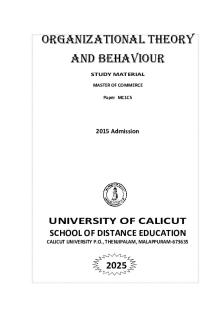
Organizational theory and behaviour
- 186 Pages
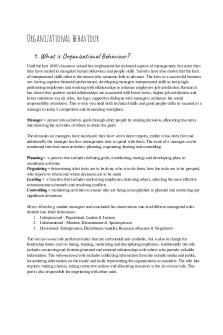
Organizational behaviour
- 67 Pages

Organizational Behaviour
- 2 Pages
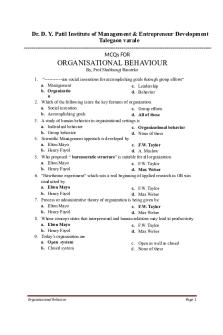
Organizational Behaviour mcqs
- 27 Pages
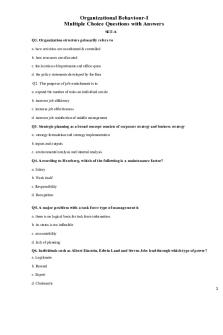
Organizational Behaviour MCQ SET
- 20 Pages
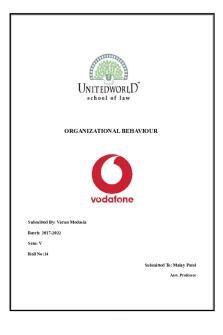
Organizational Behaviour Project
- 15 Pages

Chapter 2 ORGANIZATIONAL BEHAVIOUR
- 23 Pages

Organizational Behaviour Glossary
- 17 Pages
Popular Institutions
- Tinajero National High School - Annex
- Politeknik Caltex Riau
- Yokohama City University
- SGT University
- University of Al-Qadisiyah
- Divine Word College of Vigan
- Techniek College Rotterdam
- Universidade de Santiago
- Universiti Teknologi MARA Cawangan Johor Kampus Pasir Gudang
- Poltekkes Kemenkes Yogyakarta
- Baguio City National High School
- Colegio san marcos
- preparatoria uno
- Centro de Bachillerato Tecnológico Industrial y de Servicios No. 107
- Dalian Maritime University
- Quang Trung Secondary School
- Colegio Tecnológico en Informática
- Corporación Regional de Educación Superior
- Grupo CEDVA
- Dar Al Uloom University
- Centro de Estudios Preuniversitarios de la Universidad Nacional de Ingeniería
- 上智大学
- Aakash International School, Nuna Majara
- San Felipe Neri Catholic School
- Kang Chiao International School - New Taipei City
- Misamis Occidental National High School
- Institución Educativa Escuela Normal Juan Ladrilleros
- Kolehiyo ng Pantukan
- Batanes State College
- Instituto Continental
- Sekolah Menengah Kejuruan Kesehatan Kaltara (Tarakan)
- Colegio de La Inmaculada Concepcion - Cebu

